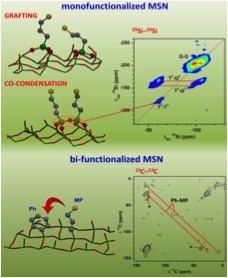
Understanding the atomic-scale distribution of sites bound to amorphous surfaces is of fundamental importance for rational design of catalysts and other functional materials, yet has challenged spectroscopists for decades. A series of our recent studies that used a combination of conventional and dynamic nuclear polarization (DNP)-enhanced solid-state (SS)NMR methods offered, for the first time, a coherent description of the distribution of organic functional groups attached to the high-surface area mesoporous nanoparticles. These studies used the previously unfeasible 2D 29Si-29Si and 13C-13C correlation measurements, enabled by the ~100-fold sensitivity enhancement via DNP, and compared the spatial distribution of surface groups in mono- and bi-functional silica-supported catalysts prepared using different synthetic routes.1,2 In addition, the distribution of organic functional groups attached to the silica surface via co-condensation was studied using triple-quantum/single-quantum (TQ/SQ) 1H-1H homonuclear correlation technique. Here, the excellent sensitivity of 1H NMR and the resolution provided by fast magic angle spinning (MAS) allowed us to study surfaces with a very low loading of functional groups (~0.1 mmol/g).3 The above methods can be applied to help optimize the synthesis of a variety of other catalytic materials.
